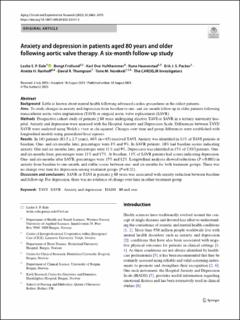| dc.contributor.author | Eide, Leslie S.P. | |
| dc.contributor.author | Fridlund, Bengt Gotthard Anton | |
| dc.contributor.author | Hufthammer, Karl Ove | |
| dc.contributor.author | Haaverstad, Rune | |
| dc.contributor.author | Packer, Erik | |
| dc.contributor.author | Ranhoff, Anette Hylen | |
| dc.contributor.author | Thompson, David R | |
| dc.contributor.author | Norekvål, Tone Merete | |
| dc.date.accessioned | 2024-01-19T08:46:37Z | |
| dc.date.available | 2024-01-19T08:46:37Z | |
| dc.date.created | 2023-08-31T12:52:35Z | |
| dc.date.issued | 2023 | |
| dc.identifier.issn | 1594-0667 | |
| dc.identifier.uri | https://hdl.handle.net/11250/3112686 | |
| dc.description.abstract | Background
Little is known about mental health following advanced cardiac procedures in the oldest patients.
Aims
To study changes in anxiety and depression from baseline to one- and six-month follow-up in older patients following transcatheter aortic valve implantation (TAVI) or surgical aortic valve replacement (SAVR).
Methods
Prospective cohort study of patients ≥ 80 years undergoing elective TAVI or SAVR in a tertiary university hospital. Anxiety and depression were assessed with the Hospital Anxiety and Depression Scale. Differences between TAVI/SAVR were analyzed using Welch’s t test or chi-squared. Changes over time and group differences were established with longitudinal models using generalized least squares.
Results
In 143 patients (83.5 ± 2.7 years), 46% (n = 65) received TAVI. Anxiety was identified in 11% of TAVI patients at baseline. One- and six-months later, percentages were 8% and 9%. In SAVR patients, 18% had baseline scores indicating anxiety. One and six-months later, percentages were 11% and 9%. Depression was identified in 15% of TAVI patients. One- and six-months later, percentages were 11% and 17%. At baseline, 11% of SAVR patients had scores indicating depression. One- and six-months after SAVR, percentages were 15% and 12%. Longitudinal analyses showed reductions (P < 0.001) in anxiety from baseline to one-month, and stable scores between one- and six-months for both treatment groups. There was no change over time for depression among treatment groups (P = 0.21).
Discussion and conclusions
SAVR or TAVI in patients ≥ 80 years was associated with anxiety reduction between baseline and follow-up. For depression, there was no evidence of change over time in either treatment group. | en_US |
| dc.language.iso | eng | en_US |
| dc.publisher | Springer | en_US |
| dc.rights | Navngivelse 4.0 Internasjonal | * |
| dc.rights.uri | http://creativecommons.org/licenses/by/4.0/deed.no | * |
| dc.title | Anxiety and depression in patients aged 80 years and older following aortic valve therapy. A six‑month follow‑up study | en_US |
| dc.type | Journal article | en_US |
| dc.type | Peer reviewed | en_US |
| dc.description.version | publishedVersion | en_US |
| dc.rights.holder | Copyright 2023 The Author(s) | en_US |
| cristin.ispublished | true | |
| cristin.fulltext | original | |
| cristin.qualitycode | 1 | |
| dc.identifier.doi | 10.1007/s40520-023-02541-5 | |
| dc.identifier.cristin | 2171377 | |
| dc.source.journal | Aging Clinical and Experimental Research | en_US |
| dc.source.pagenumber | 2463-2470 | en_US |
| dc.identifier.citation | Aging Clinical and Experimental Research. 2023, 35, 2463-2470. | en_US |
| dc.source.volume | 35 | en_US |

